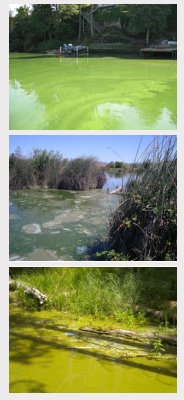This information is presented in response to questions often asked by people who have found a cyanobacteria (blue-green algae) bloom in a lake or pond on their private property.
About Blooms
Cyanobacteria, often called blue-green algae, are not algae at all but a primitive single celled bacteria found naturally in fresh and salt water. Under ideal conditions, cyanobacteria can multiply into a large visible mass called a "bloom." These blooms can be associated with toxins produced by the cyanobacteria and can cause harm to humans and animals.
How can I tell if the bloom is producing toxins?
You can't tell just by looking. Laboratory analysis of a water sample is the only way to be sure.
As a precaution, it is advisable to always avoid water that looks foamy, scummy, thick like paint, pea-green, blue-green, brownish red or white.
Should I take a water sample?
If people or animals use the water as a drinking water source, or it's used for recreation such as swimming or wading, it is recommended that you have the water tested.
Who does the sampling and what is the process?
You can hire a consultant or draw a water sample yourself. If you have decided on a lab to send samples to, OHA recommends you contact them for instructions. Sampling protocol can be found on our website: Sampling Guidelines: Cyanobacterial Harmful Blooms in Recreational Waters (pdf).
Who pays the sampling cost?
As the property owner, you are responsible for paying expenses associated with water sampling. Costs may range from $100 to $350 depending on the type of test you request and the fees the laboratory charges.
How can I find a qualified laboratory?
OHA has provided a list of Laboratories for Cyanobacteria Testing (refer to pages 14-15). Please note that OHA does not endorse any specific laboratory.
What should I ask the lab to test for?
The most economical test is identification and enumeration. This identifies the type of species and the number of cells present in the bloom. Although more expensive, toxin testing is the most accurate way of knowing if the bloom is harmful. This test identifies the type and amount of toxins present in the bloom. Refer to the Public Health Advisory Guidelines (pdf) or contact OHA if you need assistance in understanding the results provided by the lab.
How do I ship the water sample?
The Sampling Guidelines (pdf) on page 9 explains shipping methods depending on the test you request. OHA also recommends contacting your lab to ask them how they want the sample packed and shipped.
What should I do while I’m waiting for laboratory results?
Identification and enumeration can take several days to one or two weeks. Toxin testing should take no more than 3 business days. In the meantime it's recommended that you post a warning sign to alert people that an algae bloom and toxins may be present. If livestock, small animals or pets are likely to get into the water, consider putting up a temporary fence.
What kinds of illness can cyanobacteria cause?
Different cyanobacteria species produce different toxins: neurotoxins affect the nervous system, hepatotoxins affect the liver and lipopolysaccharides affect the skin. Detailed information can be found on page 9 of the Sampling Guidelines (pdf).
Health effects from bloom affected water: Skin irritation or rash caused by skin contact. Allergy-like symptoms such as eye, ear and throat irritation from Inhaling water droplets. Flu-like symptoms including diarrhea, cramps and vomiting from swallowing affected water. More severe symptoms are fainting, numbness and dizziness. The most severe reactions occur when large amounts of water are swallowed. If symptoms persist consult your doctor. Children and pets are at increased risk because of their size and level of activity.
Is it safe to eat fish caught from my pond or lake with a bloom?
Eating fish from water with a bloom presents an unknown health risk. Toxin accumulation studies suggest that muscle tissue is less affected by algae toxins, but not enough research has been done in this area. If you decide to eat the fish, remove the fat, skin and organs before cooking.